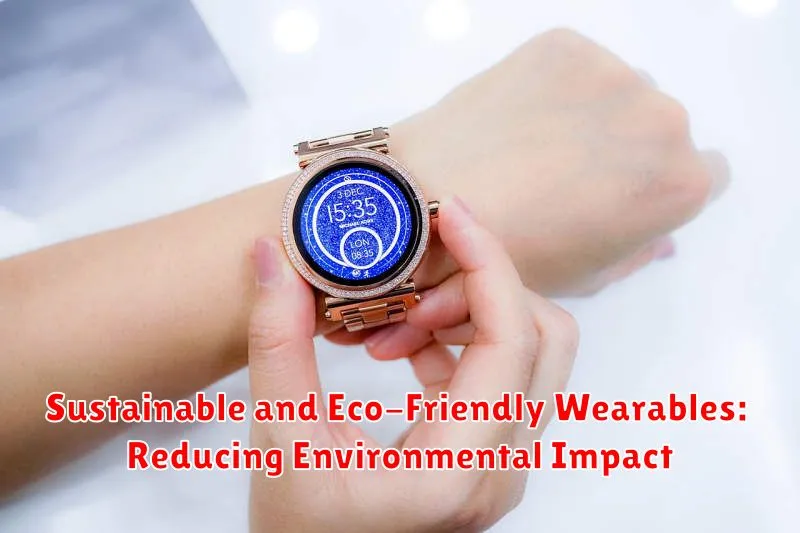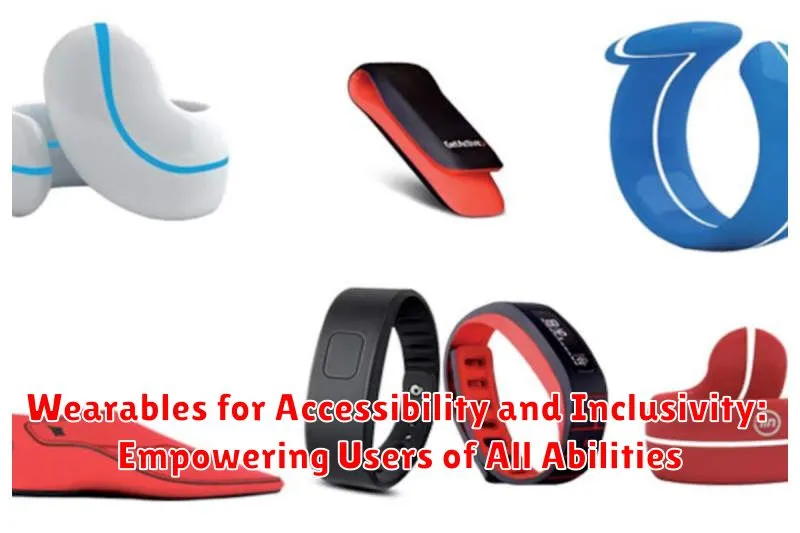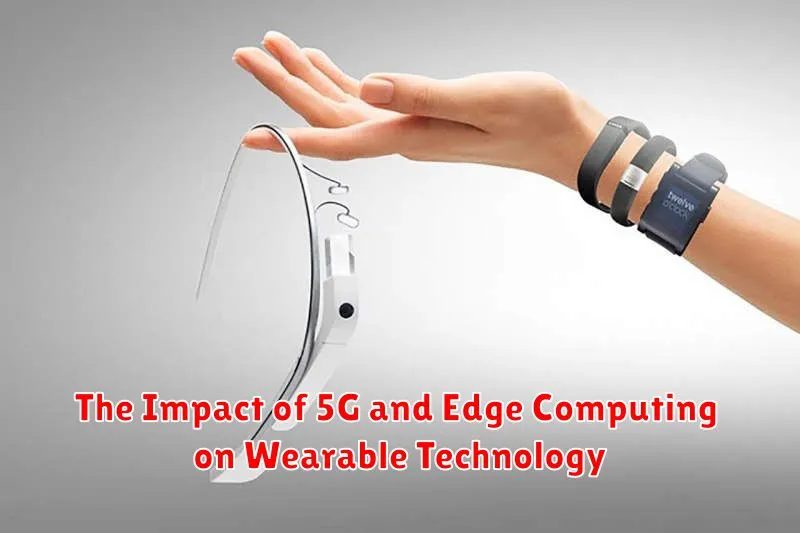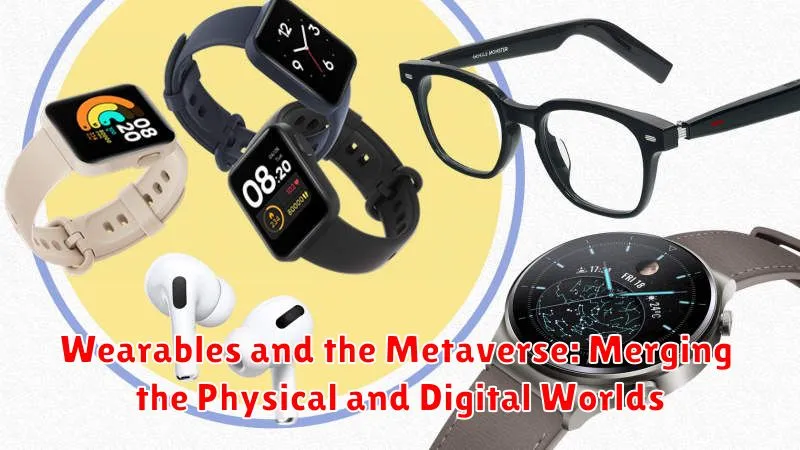The world of wearable technology is constantly evolving, with new innovations and trends emerging every year. 2024 promises to be a particularly exciting year for the wearables market, with advancements in artificial intelligence (AI), biometric tracking, and connectivity shaping the future of connected living. From smartwatches and fitness trackers to augmented reality (AR) glasses and smart clothing, wearable devices are becoming increasingly integrated into our daily lives, transforming the way we interact with the world around us.
This article will delve into the latest wearable technology trends expected to dominate 2024, exploring how these innovations are revolutionizing healthcare, fitness, entertainment, and more. We will examine the key advancements driving this evolution, including the rise of personalized experiences, the increasing use of biometric data, and the growing importance of interoperability between devices. Get ready to discover how wearable technology is set to reshape the landscape of connected living in 2024 and beyond.
Beyond Smartwatches and Fitness Trackers: The Expanding World of Wearables
The world of wearable technology has exploded beyond the confines of smartwatches and fitness trackers. In 2024, we’re witnessing a dramatic shift towards more specialized and integrated wearables that cater to a wider range of needs and lifestyles. This evolution goes beyond simply tracking steps and heart rate; it’s about enhancing our daily lives in meaningful ways.
From smart glasses that enhance our visual experiences to wearable health monitors that provide real-time insights into our bodies, the possibilities are endless. Imagine augmented reality glasses guiding you through a new city or biometric sensors monitoring your stress levels throughout the day. These are just a glimpse into the future of connected living, where wearables seamlessly integrate into every aspect of our lives.
The expansion of wearable technology is driven by several key factors. Advances in miniaturization and sensor technology have enabled the development of smaller, more powerful devices. Increasingly affordable connectivity, including 5G, has made it easier for wearables to communicate with each other and the internet. And, perhaps most importantly, consumers are demanding more than just basic fitness tracking; they want wearable devices that improve their overall well-being and productivity.
As the wearables market continues to evolve, we can expect even more innovative and personalized experiences. Imagine a future where your wearable AI assistant learns your preferences and proactively assists you throughout the day. Or perhaps smart clothing that adapts to your environment and provides optimal comfort and performance. The possibilities are truly exciting, and 2024 promises to be a pivotal year in the wearable technology revolution.
Key Wearable Technology Trends Shaping 2024
The world of wearable technology is rapidly evolving, with new innovations and advancements emerging constantly. 2024 promises to be a pivotal year, with several key trends shaping the future of connected living. From enhanced health and fitness tracking to immersive experiences and improved accessibility, these trends are set to revolutionize how we interact with technology and live our lives.
1. Advanced Health and Wellness Monitoring: Wearables are becoming increasingly sophisticated in their ability to monitor various aspects of our health. Expect to see devices that can track more than just steps and heart rate. Advanced sensors will provide real-time insights into sleep quality, stress levels, blood oxygen saturation, and even early signs of potential health issues. This data can empower individuals to make proactive decisions about their well-being.
2. Integration with Smart Homes and Cities: Wearables are no longer isolated devices. They are seamlessly integrating with smart homes and cities. Imagine controlling your home’s temperature, lighting, and appliances with a simple gesture or voice command from your smartwatch. As cities become more connected, wearables will play a crucial role in providing real-time information on traffic, transportation, and even emergency services.
3. Immersive Experiences: Wearable technology is blurring the lines between the physical and digital worlds. Augmented reality (AR) and virtual reality (VR) are finding their way into wearables, creating immersive experiences that enhance entertainment, education, and even work. Imagine experiencing a virtual museum tour or receiving real-time directions overlaid on your real-world view through your smart glasses.
4. Increased Focus on Accessibility: Wearable technology is becoming more inclusive, aiming to provide solutions for individuals with disabilities. Smartwatches with braille displays, hearing aids with advanced noise cancellation, and adaptive controllers for gaming are just a few examples of how technology is empowering people with disabilities.
5. Personalization and Customization: The future of wearables lies in personalization. Devices will be tailored to individual needs and preferences, allowing users to customize their experience. From choosing specific health metrics to tracking, to designing unique watch faces, wearable technology will adapt to individual lifestyles.
As wearable technology continues to evolve, it will become an indispensable part of our lives, enhancing our health, connecting us to the world around us, and making our lives more efficient, accessible, and engaging.
The Rise of Health-Focused Wearables: Monitoring, Prevention, and More
The world of wearable technology is rapidly evolving, and in 2024, health-focused wearables are poised to take center stage. These devices are no longer just fitness trackers; they are becoming powerful tools for monitoring, preventing, and managing health conditions.
Beyond basic activity tracking, wearables now offer advanced features like:
- Continuous heart rate monitoring for early detection of arrhythmias.
- Sleep tracking to identify sleep disorders and optimize sleep quality.
- Stress and mood monitoring using biometrics and AI-powered analysis.
- Blood glucose monitoring for individuals with diabetes.
- Electrocardiogram (ECG) readings for potential heart problems.
The data collected by these wearables can provide valuable insights into individual health patterns and empower users to take proactive steps towards a healthier lifestyle. Early detection of potential health issues can lead to timely interventions and better treatment outcomes.
Moreover, the increasing adoption of artificial intelligence (AI) in wearable technology is driving further innovation. AI algorithms are being used to analyze health data, identify trends, and provide personalized recommendations. This data-driven approach is transforming how we understand and manage our health.
As health-focused wearables continue to evolve, we can expect to see even more advanced features and capabilities. The future of connected living is one where technology plays a crucial role in promoting wellness and empowering individuals to take control of their health.
VR and AR Integration: Taking Wearables to the Next Level
The integration of virtual reality (VR) and augmented reality (AR) into wearable technology is revolutionizing the way we interact with the world around us. This convergence of technologies is paving the way for immersive and interactive experiences that are transforming industries and enriching our daily lives.
VR, with its ability to create fully immersive virtual environments, is being incorporated into wearables to enhance gaming, training simulations, and even healthcare applications. Imagine wearing a VR headset that allows you to train for complex surgical procedures or experience a historical event firsthand.
AR, on the other hand, overlays digital information onto the real world, enhancing our perception of reality. AR wearables are being used in various sectors, from navigation and shopping to education and entertainment. Imagine using AR glasses to navigate a new city, try on clothes virtually, or get real-time information about your surroundings.
The fusion of VR and AR in wearables is creating exciting possibilities. AR can enhance VR experiences by providing contextual awareness and interaction with the real world, while VR can immerse users in AR environments for more engaging experiences. This synergy is opening up a world of possibilities, from interactive learning environments to innovative entertainment experiences.
As VR and AR technology continues to advance, we can expect even more innovative and transformative wearable applications. The integration of these technologies will continue to blur the lines between the physical and digital world, making our lives more connected, immersive, and enriching.
Wearables in the Workplace: Enhancing Productivity and Safety
The workplace is undergoing a significant transformation, driven by the rapid evolution of technology. Among the most notable trends is the increasing adoption of wearables, which are revolutionizing how we work, interact, and stay safe. Wearables offer a range of functionalities that can enhance productivity, improve safety, and create a more connected and efficient work environment.
In the realm of productivity, wearables can play a crucial role by streamlining tasks, optimizing workflows, and providing real-time insights. Smartwatches, for instance, can be used for task management, scheduling appointments, and receiving instant notifications, ensuring that employees stay on top of their responsibilities. Augmented reality (AR) glasses can provide hands-free access to information and instructions, enabling workers to perform complex tasks with greater accuracy and efficiency.
Furthermore, wearables have the potential to significantly enhance safety in the workplace. Smartwatches can monitor vital signs like heart rate and blood pressure, alerting emergency personnel if any abnormalities are detected. Wearable sensors can detect falls and other accidents, triggering immediate assistance. In hazardous environments, these devices can track worker location and provide real-time alerts in case of emergencies.
As wearable technology continues to evolve, we can expect even more innovative applications in the workplace. Wearables have the power to redefine how we work, interact, and stay safe, creating a more connected, efficient, and secure future of work.
The Growing Importance of Data Security and Privacy
As wearable technology continues to evolve and integrate into our daily lives, the importance of data security and privacy becomes increasingly paramount. These devices collect a wealth of personal information, from our location and movement patterns to our health data and even our sleep patterns.
This data is incredibly valuable, not just for individuals but also for businesses and researchers. It can be used to improve health outcomes, personalize experiences, and develop new products and services. However, this same data can also be exploited if it falls into the wrong hands.
The potential risks associated with data breaches involving wearable devices are significant. Identity theft, financial fraud, and even physical harm are real possibilities. Therefore, it is crucial that both consumers and developers prioritize data security and privacy when it comes to wearable technology.
Here are some key areas to focus on:
- Encryption: Data collected by wearables should be encrypted both during transmission and storage. This makes it much more difficult for unauthorized individuals to access and use the data.
- Data Minimization: Devices should only collect data that is absolutely necessary for their intended purpose. Limiting the amount of data collected reduces the potential for misuse.
- User Control: Users should have clear control over their data, including the ability to access, delete, or restrict the sharing of their information.
- Transparency: Developers should be transparent about the data they collect, how they use it, and what security measures are in place to protect it.
The future of connected living relies on the responsible use of wearable technology. By prioritizing data security and privacy, we can ensure that these innovations benefit society without compromising our personal information. As consumers, we must be vigilant and informed, while developers must prioritize ethical practices and robust security measures. Together, we can shape a future where wearable technology empowers us without putting our privacy at risk.
Sustainable and Eco-Friendly Wearables: Reducing Environmental Impact

The wearable technology market is booming, with smartwatches, fitness trackers, and other connected devices becoming increasingly popular. But with this growth comes a concern about the environmental impact of these devices. Thankfully, a growing number of companies are prioritizing sustainability in their wearable designs, focusing on eco-friendly materials and responsible manufacturing practices.
One of the key areas where sustainability is being addressed is in the use of materials. Instead of using traditional plastics and metals, manufacturers are exploring alternative materials like recycled plastic, bio-based polymers, and even plant-based materials. These materials have a lower environmental footprint, reducing the reliance on virgin resources and minimizing waste.
Another crucial aspect is the manufacturing process. Companies are adopting circular economy principles, emphasizing repairability, modularity, and recyclability. This ensures that devices are designed for longevity and can be easily repaired or upgraded, reducing the need for constant replacements.
In addition, the focus on energy efficiency is paramount. Manufacturers are optimizing battery life and incorporating features that promote responsible energy consumption. This minimizes the reliance on batteries and reduces the overall environmental footprint of the device.
The trend toward sustainable and eco-friendly wearables is not just about reducing environmental impact; it also aligns with consumer preferences. Increasingly, consumers are seeking products that are ethically and environmentally responsible. By embracing sustainability, wearable technology companies can appeal to this growing market segment while contributing to a greener future.
Investing in the Future of Wearables: Key Players and Innovations

The wearable technology market is experiencing explosive growth, and for good reason. From fitness trackers to smartwatches, these devices are seamlessly integrating into our daily lives, offering convenience, health monitoring, and even entertainment. As we delve deeper into 2024, the focus shifts to understanding the key players shaping this industry and the groundbreaking innovations driving its future.
Apple, a pioneer in the wearable market, continues to dominate with its Apple Watch series, boasting a comprehensive ecosystem and advanced health features. Samsung, a close competitor, offers its own line of Galaxy Watch devices, emphasizing design and functionality. Meanwhile, Fitbit remains a leading force in fitness tracking, capturing the attention of health-conscious individuals.
Beyond the established giants, several startups and emerging companies are making significant waves. Whoop, with its focus on athletic performance tracking, has gained immense popularity among athletes. Oura Ring, a discreet wearable for sleep tracking and health insights, has attracted a dedicated user base. These players demonstrate the diverse and innovative landscape of the wearable industry.
Innovation is the driving force behind the future of wearables. Advancements in sensor technology are enabling more accurate health data collection, from heart rate variability to sleep quality. Artificial intelligence (AI) is being integrated to provide personalized insights and predict potential health issues. Augmented reality (AR) is enhancing the user experience, offering immersive overlays and interactive functionalities.
As wearables become increasingly sophisticated, they are poised to impact various aspects of our lives, from healthcare and fitness to entertainment and communication. Understanding the key players and the transformative innovations driving this market is crucial for anyone seeking to invest in the future of connected living.
Wearables for Accessibility and Inclusivity: Empowering Users of All Abilities

In 2024, wearables are not just about fitness trackers and smartwatches; they’re becoming powerful tools for accessibility and inclusivity. This transformative potential lies in their ability to bridge gaps and empower individuals with diverse needs.
One key area is assistive technology. Wearables can act as sensory aids for people with visual or auditory impairments. Imagine smart glasses with built-in voice recognition and object identification, enabling blind individuals to navigate their surroundings with ease. Smartwatches with haptic feedback can provide tactile cues for deaf individuals, translating sound into vibrations for enhanced communication.
Beyond sensory support, wearables are empowering individuals with mobility challenges. Smart prosthetics equipped with sensors and actuators can provide intuitive control and enhanced functionality. Exoskeletons are being developed to assist individuals with paralysis or limited mobility, enabling them to walk, stand, and regain a sense of independence.
The inclusivity aspect extends to mental health as well. Wearables can monitor physiological signals like heart rate, sleep patterns, and stress levels, offering valuable insights into mental well-being. This data can empower individuals to proactively manage their mental health, promoting early intervention and reducing stigma associated with seeking help.
While the journey is still ongoing, 2024 marks a significant step forward in leveraging wearable technology to create a more inclusive and accessible world. As technology continues to advance, we can expect even more innovative solutions that empower individuals of all abilities to live fulfilling and independent lives.
The Impact of 5G and Edge Computing on Wearable Technology

The convergence of 5G and edge computing is set to revolutionize the landscape of wearable technology. These technologies work in tandem to enable real-time data processing and analysis, unlocking new possibilities for wearable devices.
5G, with its blazing fast speeds and low latency, empowers wearables to handle more complex data streams and respond to user interactions in an instant. This translates to smoother, more responsive experiences, especially for applications like augmented reality (AR) and virtual reality (VR) integrated into wearables.
Edge computing, on the other hand, brings processing power closer to the source of data – the wearable device itself. This minimizes the reliance on centralized servers, resulting in faster response times, reduced network congestion, and improved data security.
The combination of 5G and edge computing paves the way for a new generation of smart wearables that can:
- Provide real-time health monitoring and personalized insights.
- Enhance fitness tracking with detailed biometrics and performance analysis.
- Enable seamless AR/VR experiences with low latency and high-quality visuals.
- Deliver more personalized and context-aware interactions through voice assistants.
As 5G and edge computing continue to mature, we can expect to see increasingly sophisticated and interconnected wearable devices that empower users with greater control over their health, fitness, and daily lives.
Wearables and the Metaverse: Merging the Physical and Digital Worlds

The metaverse, a collective virtual shared space, is poised to revolutionize how we interact with technology and the world around us. At the forefront of this transformation are wearable technologies, acting as the bridge between the physical and digital realms.
Wearables are no longer just fitness trackers and smartwatches. They are evolving into powerful tools that enhance our senses, expand our abilities, and connect us to the digital world in unprecedented ways. In the metaverse, wearables will become essential for creating immersive experiences, enabling users to interact with virtual environments, and communicate with others in new and engaging ways.
Imagine stepping into a virtual world through a pair of augmented reality (AR) glasses, where digital overlays appear seamlessly on your real-world view. These glasses could provide real-time information, translate languages, or even guide you through a virtual map. Or consider the potential of haptic suits, which allow users to feel virtual objects and environments, creating a more immersive and interactive experience.
As the metaverse evolves, wearables will play a crucial role in shaping the future of connected living. They will become the gateway to virtual worlds, enabling seamless interaction with digital environments and pushing the boundaries of human experience.

